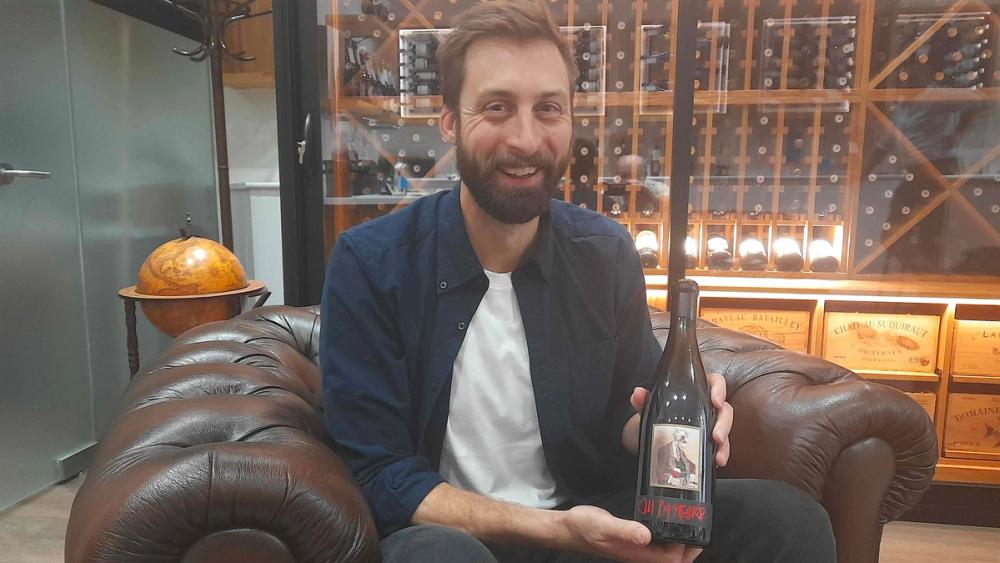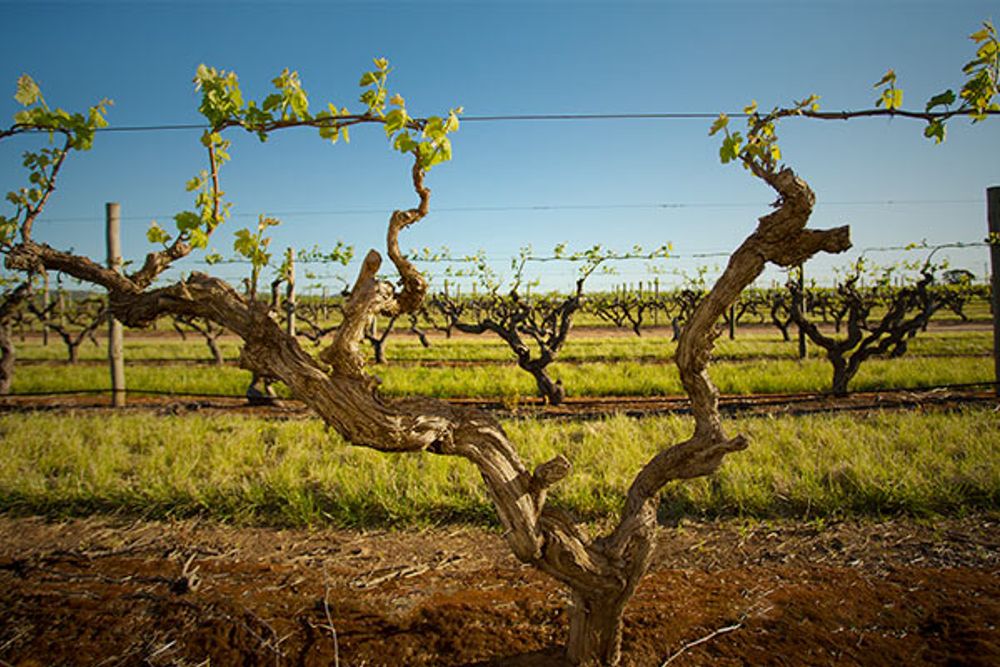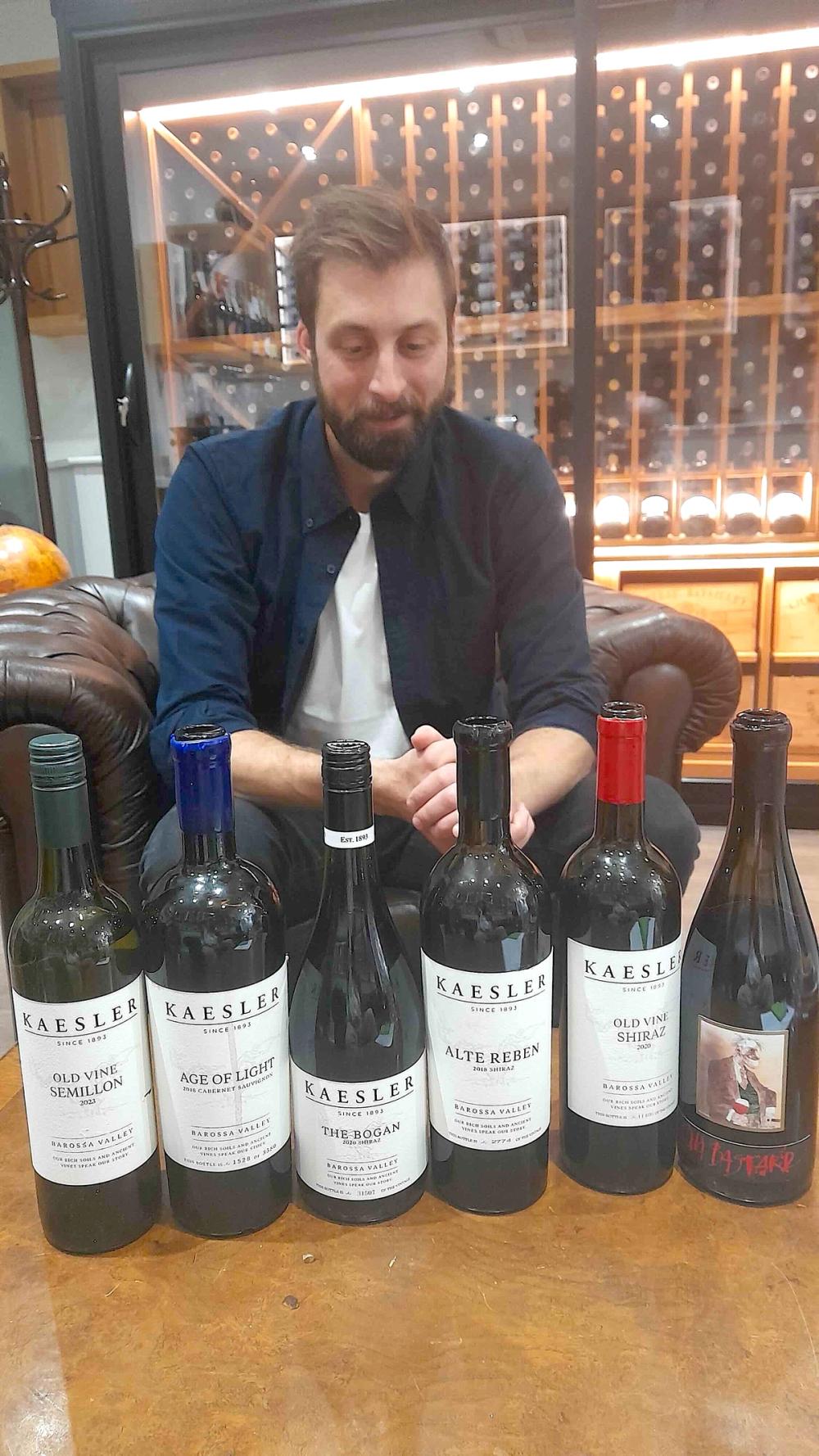The oldest surviving Shiraz vines in the world are thought to have been planted in 1843 at Langmeil in the Barossa Valley, only a few kilometres from the Kaesler vineyards just outside the town of Nuriootpa. Their first vines were put in exactly fifty years later in 1893, earning them royalty status within the region. And the latest vintages of their wines that Jeroboams will be bringing to UK shores this autumn are nothing less than princely.
Kaesler’s chief winemaker, Tim Dolan, jetted in from South Australia in mid-summer to show a striking sextet of wines. Ironically, he could only take the credit for one of them - the Old Vine Semillon 2023 - as he was not not recruited until September 2022. The five red wines he brought with him were all produced between 2018 and 2021.

Kaesler head winemaker Tim Dolan showing off the latest 2020 Old Bastard Shiraz
It was something of a coup for Kaesler to lure the talented and highly affable Dolan from Peter Lehmann in nearby Tanunda, for he comes from a family with an impeccable winemaking pedigree. Grandfather Bryan won the first ever Jimmy Watson Trophy, the most coveted award for a wine in Australia. That was back in 1962, and Tim’s father, Nigel, enjoyed an equally distinguished career himself winning the same trophy in 2003 at Saltram, where Tim grew up. In 2018, Tim, then 33, won the prestigious ‘Dux’ award of the Len Evans Tutorial, beating 11 other young Australian winemakers in a week of blind-tasting and assessment by their older peers.
That took place in the Hunter Valley, which was fitting given Dolan’s love of that region’s style of Semillon. At Peter Lehmann, he followed the Hunter’s practice of picking early at no more than 11 Baumé before fermentation in tank and bottling straight afterwards. This philosophy he took with him to Kaesler with the 2023 Old Vine Semillon coming in at 11.2% abv with a very low pH of 2.98. Interestingly, the fruit from vines planted in 1962 is a field blend of 90% Semillon and several other white grapes such as Palomino and Pedro Ximenez.
“It’s just six rows of vines over maybe half a hectare that gives us about 240 dozen,” Dolan revealed. “We picked it in February but, if it’s really dry, we might pick late January. All the fruit went in and was co-fermented. But 2023 was very similar to 2011 - a cool and wet vintage. The 2011s are stunning right now - honeyed with some toast and a little bit of lanolin.”
The 2023 promises to be a cracker, either best drunk within 2-3 years or left until after 2030 to avoid Semillon’s renowned dumb mid-life phase.

The majority of Kaesler's vineyards are made up of old vines
Kaesler, though, is best known for its quartet of Shiraz labels, but before tasting them, Dolan was keen to highlight the quality of the ‘Age of Light’ Cabernet Sauvignon 2018. This is the first vintage of this label, which is made in very small quantities and comes from the best fruit on several blocks, the oldest of which was planted in 1970. Because of the proliferation of Eutypa trunk disease (aka ‘Dead Arm’), yields are tiny – just two tons per hectare.
“This has been a bit of a journey for Kaesler in terms of Cabernet, which was a kind of afterthought,” Dolan said. “In 2009 when Matthew Jukes tasted through in the Barossa, he tore the wines to shreds. He said the Cabs were too ripe, over-extracted and not varietal. So it was decided to pick a lot earlier. It's an extraordinarily limited production of 200 cases, and I’m most excited about it. Cabernet is the second most planted varietal in the Barossa, and if done well, can be exceptional. You’re the first to see it in the UK. It was nicknamed the Old Bastard Cab but no one in the company knows where the name ‘Age of Light’ came from. Someone must have just blurted it out and we ran with it. But it’s a great name.”
Talking of iconic names for labels, ‘The Bogan’ has attracted a cult following in Australia. The Aussie vernacular for a rough, uncouth red-neck, typically unshaven with a mullet, it is hardly reflective of what is a highly polished wine. But the slang appeals to the national psyche, breaking down barriers and drawing numerous consumers to the cellar door who want to taste and buy it, and nothing else. While the 2020 was “a gem from a really tough year” in Dolan’s words, the 2021 was a great vintage, the best Bogan that has ever been made according to Stephen Dew, senior winemaker at Kaesler since 2002. The fruit comes from a blend of estate parcels planted between 1899 and 1965.
Kaesler’s Old Vine Shiraz 2020 is made from three estate vineyards that are 52, 72 and 124 years old. The difference between this wine and its Alte Reben (German for ‘old vines’) Shiraz 2018 is that the fruit comes from vines planted in 1899 at the company’s Marananga vineyard 8km from the winery, where the soils are different.
“There’s something special about the Alte Reben block, which produces a very elegant wine, not a ball-buster,” Dolan declared. “The vines were bush vines but they’ve been trained and look like they’ve been tended for every day of their lives. By contrast, the Old Bastard vines look like they’ve been let go for a while. The soils aren’t as generous as the Kaesler soils, which are a lot deeper and more fertile although both are sandy loam over clay. That clay layer is very important as it definitely saves us in summer.”
The Old Bastard Shiraz 2020 is the product of 12 rows planted in 1893 that make up just over a hectare of vines sat behind the winery in Nuriootpa. Sadly, another hectare of these same ancient vines were grubbed up in the national vine pull of the 1980s.
“There’s attrition every year - you see it,” Dolan sighed. “We at least get quite large bunches as the clone is different to that of Alte Reben. In a good year, we get 5-6 tons off this block. The berries are tiny and give incredible concentration. This vintage is a gem but you need to give it some time as it’s going to develop into something pretty special.”

Special is certainly a word that could be applied to the full Kaesler range, which is notable for how well balanced the wines are. If, like most winemakers in the region, Dolan may need to add between 0.5-1g/l of tartaric acid to the reds, he has brought alcohol levels down by picking at mid to high 13 Baumé compared to 14-15 previously. He has pared back the amount of new oak used and looked to vary vessel size, with a 2,000 litre foudre recently installed. None of the wines have been fined since arriving, with only the most sophisticated form of filtration - crossflow - employed.
Credit must also go to the work done by viticulturist Nigel van der Zande, who has been vineyard manager since 2001.
“Our improvement of soil health using composts has improved vine health, and we tend to see flavour at lower sugars,” he said. “This helps us to achieve more balanced, fresher wine, requiring very little acid adjustment. Our attention to sustainable, regenerative farming techniques is allowing us to produce fruit with elegance.”
These techniques include allowing mid-rows to support an increasing mix of native plants, which are largely kept down by grazing with sheep; the slashing of grasses only twice a year (between rows and under vine at the same time to reduce compaction and fuel usage); the replacement of fertilisers with an annual compost application; and minimal irrigation prompted by data from soil-moisture probes. These practices have helped lift organic soil carbon levels from 0.8% to 1.8% over the last decade. This sequestration of carbon builds the health of the soil, promising better fruit for Dolan in his quest to maintain, and lift higher still, the quality of Kaesler’s world-class wines.
So how were the Kaesler wines tasting?

‘Old Vine’ Semillon 2023
Crisp, dry and pristine with lemon, green apple and lime notes as well as hints of dried herbs and wild flowers. A delight now but its taut, crystalline acidity (7g/l TA) will allow it to age gracefully for many years. As made in the Hunter Valley style (lower alcohol, no oak influence), it should develop honeyed, toasty notes after 6-7 years of cellaring. 11.2% abv (POA)
‘Age of Light’ Cabernet Sauvignon 2018
First vintage of this beguilingly fresh Cabernet, which is only made in the best years. Beautiful blackberry, mulberry and black cherry notes with hints of leather. Seamlessly fine tannins, wonderful concentration and a very long finish. 100% new oak effortlessly absorbed, giving it structure to last many years, if you can resist it now. Underlines how good Barossa Cabernet can be. 14% abv (RRP £89)
The Bogan Shiraz 2021
Not a surprise that Stephen Dew’s 20th Bogan is, in his view, the best. An absolute ripper of a wine that is perfectly in balance: luxuriant, complex black plum and blueberry fruit with hints of dark chocolate; a full body and ample structure from 30% new oak (the balance second and third fill) for 16 months; bright acidity and spicy, savoury, ripe tannins on the finish comfortably carry the alcohol. Long with massive concentration, yet still elegant. 14.5% abv (£34.50)
‘Old Vine’ Shiraz 2020
Dense purple-crimson with luscious blue and black fruit notes with hints of chocolate, liquorice and earth spices. Cuttings from the Old Bastard vines. Aged in puncheons (40% new) for 16 months. Soft with delicate, fine tannins. 14.5% abv (£40.95)
‘Alte Reben’ Shiraz 2018
Raspberries and red plums on the nose, giving way to blueberries, bitter chocolate and spicy oak on the palate. Fruit picked in three different stages to achieve the best balance. Soft, silky tannins and ample freshness with fabulous length. Such a refined wine with so many layers. 14.5% abv (£75)
‘Old Bastard’ Shiraz 2020
Those drinkers wanting a powerful Shiraz with finesse should look no further than this graceful Old Bastard. Profound fruit depth and purity with melt-in-the-mouth tannins and a prodigiously long finish with simmering heft. Complex layers of dark plum and blackberry fruit with black forest gateau, creme de cassis, chocolate and spice. So much seems to be packed into the wine but everything is in balance. A stunner. 14.5% abv (£127)







































